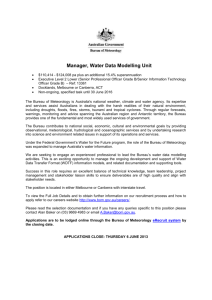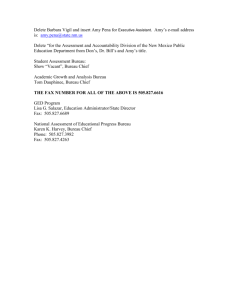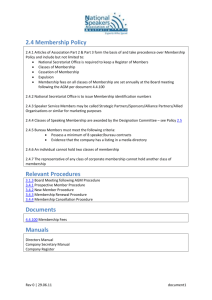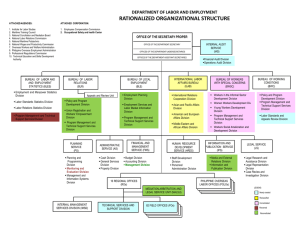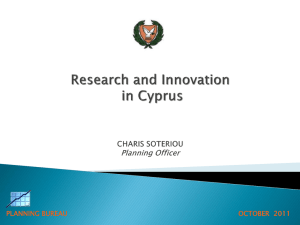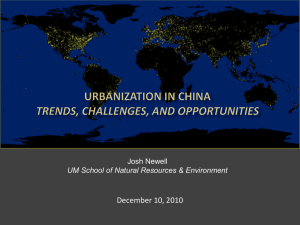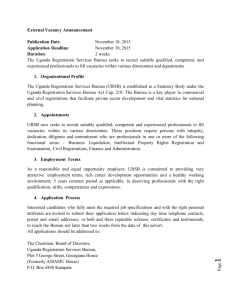DOCX: 362 KB - Department of Industry website
advertisement
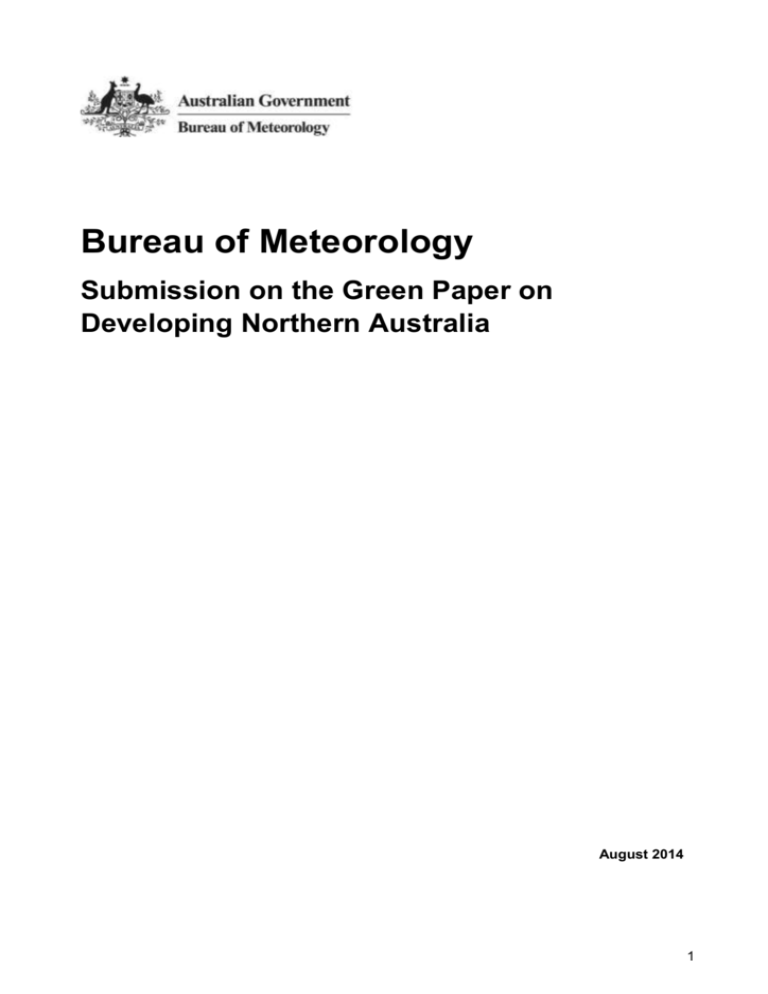
Bureau of Meteorology Submission on the Green Paper on Developing Northern Australia August 2014 1 For further information on this submission please contact: Graham Hawke Division Head Environment and Research E-mail: xxxxxxxxxxxx Phone. : xx xxxx xxxx Version No: 1 Date of Issue: August 2014 Confidentiality This is a public submission, it does NOT contain ‘in confidence’ material and can be placed on the Taskforce’s website. © Commonwealth of Australia 2014 This work is copyright. Apart from any use as permitted under the Copyright Act 1968, no part may be reproduced without prior written permission from the Bureau of Meteorology. Requests and inquiries concerning reproduction and rights should be addressed to the Communication Section, Bureau of Meteorology, GPO Box 1289, Melbourne 3001. Requests for reproduction of material from the Bureau website should be addressed to AMDISS, Bureau of Meteorology, at the same address. 2 Contents This Submission ............................................................................................................................ 4 About the Bureau .......................................................................................................................... 4 Established presence in northern Australia ................................................................................... 5 Understanding the risk of investing in northern Australia ............................................................... 6 Contemporary weather and hazards information ........................................................................... 7 Supporting business activity .......................................................................................................... 7 Helping communities and industry to manage extremes ............................................................... 8 Comprehensive water information ................................................................................................. 8 Informing infrastructure design, location and maintenance ............................................................ 9 Table 1: Applications of the Bureau’s services and capabilities in the context of the nominated policy directions for northern Australia........................................................................................... 5 Table 2: Key Bureau of Meteorology services (and products) and applications ........................... 11 3 This Submission The Bureau of Meteorology (‘the Bureau’) welcomes the opportunity to make this submission on the Green Paper on Developing Northern Australia. This submission is provided in addition to the information about the climate of northern Australia provided by the Bureau as part of the development of the Green Paper. In this submission, the Bureau outlines its current presence in northern Australia and its contribution to safety, sustainability, well-being and prosperity. The submission also describes the Bureau’s main capabilities relevant to further development of northern Australia with a link to the six possible policy directions outlined in the Green Paper. Further information about any aspects of the Bureau’s submission can be provided upon request (see contact details above). About the Bureau The Bureau of Meteorology is Australia’s national weather, climate and water information agency, operating under the authority of the Meteorology Act 1955 and the Water Act 2007. The Bureau’s mission is to: Monitor and report on current environmental conditions; Analyse and explain trends in environmental data; Provide forecasts, warnings and long-term outlooks on environmental phenomena that affect the safety, prosperity and resilience of Australians; and Foster greater public understanding and use of environmental intelligence. The Bureau provides a wide range of accurate, timely and reliable products and services to support informed decision making by governments, emergency services, the community and business and industry. A summary of the Bureau’s main service offerings are displayed below. 4 The Bureau’s products and services are made available to the Australian community through the mass media including radio, television and newspapers and the internet. Table 1 (below) shows applications of the Bureau’s services and capabilities in the context of the nominated policy directions for northern Australia. Table 2 (page 11) lists key Bureau services (and products) and their applications. Environmental intelligence The Bureau of Meteorology specialises in identifying and interpreting diverse sources of environmental data, and through its monitoring, analysis and forecasting activities, presenting environmental intelligence to guide daily decision making and influence long-term planning. The Bureau provides environmental intelligence for Australian communities, emergency services, businesses and governments for safety, sustainability, well-being and prosperity. Table 1: Applications of the Bureau’s services and capabilities in the context of the nominated policy directions for northern Australia Infrastructure Land Water Climate-appropriate infrastructure Assessing agricultural viability Protecting infrastructure from severe weather Weather-responsive business decisions Assessing the potential of new dams and water infrastructure Infrastructure siting to minimise flood impacts Flood and floodplain management Coastal developments Environmental management Trade and investment Research and training Governance Services to underpin safe and efficient aviation and shipping Research capability located in the north Cross jurisdiction frameworks for cooperation Specialist training programs deploying graduates in northern Australia International linkages with neighbouring countries Services to support offshore oil and gas Risk management and insurance Water allocations and rights Water supply and Irrigation Ecosystem management Industry and public education on northern climate and weather Established presence in northern Australia The Bureau is well embedded in northern Australia, with established relationships with State and Territory Governments through to remote communities. Three of the Bureau’s regional offices provide meteorological forecast and warning services to northern Australia. These are located in Darwin (serving the Northern Territory), Perth (serving Western Australia) and Brisbane (serving Queensland). These offices work very closely with Federal, State and Local government agencies and authorities, as well as with industry and community groups. The Bureau has staffed stations 5 in other northern Australian centres including Port Hedland, Broome, Alice Springs, Mount Isa, Cairns, Townsville, Mackay and Rockhampton and is represented in remote locations such as Hall’s Creek, Gove, Tindal and Weipa (some of which primarily service the Department of Defence). Through its Reconciliation Action Plan, the Bureau is also deepening its engagement and connections with indigenous communities through a wide range of initiatives. The Bureau operates a comprehensive network of weather watch radars, automatic weather stations, climate monitoring and rainfall stations and stream gauges across northern Australia. The Bureau has long been regarded as a trusted advisor to key industries in the north, particularly the resource and agricultural sectors and also has a stable history of working across jurisdictions. Many of the Bureau’s services are delivered in partnership with State and Territory governments using data collected by all levels of government, from nations from across the world as well as from Australian corporations and individuals. The Bureau is currently working within the Council of Australian Governments (COAG) framework to standardise its weather services across State boundaries and strengthen the consistency of information available. Policy direction significance Infrastructure Land Water Trade & Invest Edu. & Res. Governance Understanding the risk of investing in northern Australia Business and government investment, risk management and operational decisions for northern Australia need to be guided by a well-informed understanding of the climate and the associated risks. The Bureau’s service offering contributes directly to understanding and explaining the nature, variation and variability of the northern environment, and the risks for current and future investment in people, infrastructure, production and trade. Developing northern Australia requires 'de-risking' investment, which in turn requires aggregation and synthesis of information to inform investment opportunity prospectuses. To help achieve this, the Bureau has high quality weather, climate, water and ocean information, including spatial information (Geofabric), and can package comprehensive environment intelligence to meet the needs of potential investors. Beyond the issues of access and tenure, one of the major barriers to opening-up northern land to more innovative use is the lack of access to baseline information about the land itself, for example, soil type, extant vegetation and animal life, ecosystems and biodiversity, including valued species and pests, water abundance and quality. Easy access to existing environmental data and information would inform assessments and decisions about how the land might be used and what impact development and use might have on the environmental assets of the region. Easy access and re-use of existing environmental datasets would also reduce some of the datagathering burden of Environmental Impact Assessments. The Bureau and the Department of the Environment are jointly implementing the government’s National Plan for Environmental Information initiative. The core of this initiative is the development of a national environmental information infrastructure – part of the Australian Government’s open data agenda and a key mechanism for unlocking the re-use value of our environmental information assets. This initiative will help to provide information needed to assist proponents understand the development potential of the land and ensure development is not at odds with environmental protection in northern Australia. Policy direction significance Infrastructure Land Water Trade & Invest Edu. & Res. Governance 6 Contemporary weather and hazards information The high incidence and severity of extreme weather events in Australia, combined with a growing population, settlement patterns and the growth of infrastructure has seen increased demand in services provided by the Bureau. The Bureau provides observations, alerts, warnings and forecasts on a 24/7 basis to protect lives and assets on land, at sea and in space and in the air, across Australia’s territory and, in some cases, internationally. The Bureau’s Next Generation Forecast and Warning System (NexGen FWS) will be available in the Northern Territory from late 2014, following implementation in Western Australia in 2012 and in Queensland in 2013. This allows seven-day forecasts to be generated for a larger number of locations, providing greater equity of service for urban and rural communities, with more frequent and detailed forecast services available. Underpinned by the capability of the Bureau’s NexGen FWS, a range of improved and tailored services could be developed in partnership with weather sensitive users. These may range from improvements to the Bureau’s products to better meet the needs of the community, and services developed for specific sectors through co-investment, through to tailored decision support systems provided on a commercial basis. Examples include agriculture pest and disease alerts, and livestock heat stress forecasts. The service delivery enhancements that will follow the implementation of the Bureau's new supercomputer from mid-2016, in particular more detailed and up-to-date forecasts and warnings, will benefit trade and business activity by assisting decision making in a wide range of weather sensitive industry sectors, including air transport and shipping activities. From 2015, the Bureau will also have access to data from a new next-generation geostationary satellite (Himawari-8) that will host significantly greater spectral, spatial and temporal resolution. This will provide far greater observational intelligence to support emergency management functions, land management and short-term thunderstorm / rainfall prediction across northern Australia. Flood forecasting and warning services in northern Australia could be improved by increasing the collection of water data in the region. The Bureau is dependent on State and Territory based water data collection programmes to access river level data and these are often not well resourced. Monitoring points tend to be in areas where development has occurred, as opposed to areas with future development potential. Increasing knowledge about convective rainfall systems and monsoonal weather patterns will also improve flood prediction to support the management of flood prone areas. Policy direction significance Infrastructure Land Water Trade & Invest Edu. & Res. Governance Supporting business activity The Bureau’s services are essential to any expansion of economic activity across northern Australia. A large number of economically important, weather-sensitive industries and organisations rely on Bureau data and forecast products to operate effectively and to mitigate weather related risk, particularly from extreme weather events. These industries include, but are not limited to agriculture, mining, aviation, shipping, fishing and tourism. The Bureau issues warnings and forecasts every day that allow for the smooth passage of international transport, which underpins Australia’s trade and investment. Transport networks within the region, to the rest of Australia and internationally, especially to partners in Asia are 7 weather-affected for much of the year. With the Australian Maritime Safety Authority expecting a 66 per cent growth in shipping traffic by 2025, particularly in northwest Australia, the Torres Strait and the Great Barrier Reef, the Bureau’s marine and ocean services will play an increasingly important role in maximising the economic benefits linked to industry needs for efficient and safe shipping operations. Similarly, the aviation sector is highly weather-sensitive with weather conditions across northern Australia presenting aviators with significant challenges. There are around 1.7 million airline passenger movements across Australia each week that depend on mandatory weather forecasts delivered by the Bureau. Policy direction significance Infrastructure Land Water Trade & Invest Edu. & Res. Governance Helping communities and industry to manage extremes The Bureau’s climate information program assists governments, industries and communities to manage the impacts of climate variability. The potential for development in the tropical north will be affected by weather and climate. The Bureau has proven capability to assist industries and communities to understand and manage these conditions. Improved use of both short-term and longer term weather and climate information, such as seasonal outlooks and short-term streamflow forecasts, will assist in harnessing opportunities for agricultural growth in high value crops and livestock, in regions with close proximity to Asia. Accurate seasonal intelligence can make the difference between whether an agricultural activity is viable. The Bureau’s seasonal climate prediction service provides seasonal and longer-range outlooks for rainfall and temperature. The Bureau’s Predictive Ocean Model for Australia (POAMA) can be tailored to provide broad scale, long-range forecasts between one and nine months ahead of key Pacific and Indian Ocean drivers of Australian climate, such as El Niño and La Niña. Agriculture and horticulture require contemporary information about climate and weather, as part of assessing crop suitability. The Bureau supports the proposed Cooperative Research Centre (CRC) considered in the Green Paper and could be an active participant in end user driven research through partnerships between researches, industry business and the community. The Bureau is in discussion with proponents of an agNORTH Cooperative Research Centre to contribute to improving agricultural viability in the north. Uncertainty around when the wet season rains will begin is one of the most challenging aspects of the tropical rainfall pattern in northern Australia. Often, at the end of a long dry-season, cattle are in dire need of green grass to feed on, while the northern fire season is just coming to a close, and water reserves are getting low. The Bureau is working on the development of a wet season onset forecast to help users manage the risk of a prolonged dry season. Policy direction significance Infrastructure Land Water Trade & Invest Edu. & Res. Governance Comprehensive water information Water access is a significant challenge in northern Australia where much of the landscape is more arid and rainfall is largely seasonal. Information about the availability of water is important to harness development opportunities for activities such as: 8 securing water supplies for irrigated agriculture (and other uses), whether through impounding surface water and/or development of groundwater resources; building water infrastructure at a scale that is cost effective and appropriate for the climate and water demands (from irrigation, urban, mining, manufacturing and service sectors); establishing a water resources planning and management framework that contributes to healthy, productive ecosystems and communities through the sustainable use of water resources; and determining the value and requirements for the managed recharge of water to aquifers for subsequent recovery or environmental benefit. The Bureau has the lead role in the provision of national water information and water availability forecasting services, through the Improving Water Information Program, which is a key pillar of the Australian Government’s water reform agenda. The Bureau’s water information roles and responsibilities are specified in the Water Act 2007 which empowers the Bureau to collect and publish water information. The program began in July 2007, funded initially for a ten-year period. The Bureau has a comprehensive repository of water entitlements and assessments, spatially enabled across northern Australia to inform 'third party' impacts of development. These include: water extracted for mining as well as extensive use of stock and domestic bores; environmental and cultural water use, for example in the Daly River, using information from the Australian Water Resources Assessments; and comprehensive continental scale water balance modelling - integrating landscape, river and groundwater flows as an enabler of water resource assessments. Water information products could be expanded to better service northern Australia. For example, the national Water Account could be expanded to include Darwin Harbour and Barron catchments and less detailed accounts could be completed for the rest of northern Australia. If the underlying data is available, streamflow forecast locations could be increased from the existing limited presence in Western Australia and the Northern Territory. Policy direction significance Infrastructure Land Water Trade & Invest Edu. & Res. Governance Informing infrastructure design, location and maintenance As the population increases across northern Australia so too will the physical and economic exposure to environmental hazards. The Bureau provides critical information to design and build resilient infrastructure including through rainfall intensity information for causeways, dams, bridges, road, drainage and irrigation design. Accurate, timely and reliable weather forecasts and warnings provide infrastructure operators with the necessary guidance to make decisions, especially in minimising shut-downs of infrastructure such as ports and airports. Construction activity can be hampered during periods of heavy rain, particularly associated with the wet season, and can be shutdown altogether by flood, tropical cyclone, bushfire or other extreme events. Similarly, the operation of transport, communications, energy and other economic infrastructure can be impacted by natural conditions, with existing infrastructure damaged from time to time due to natural forces. It is not uncommon for major roads to be cut off for many weeks or months, or for bridges to be destroyed due to flooding. The Bureau’s existing weather forecast and warning capability will be enhanced significantly in the next two years as a result of increased supercomputing capability and richer observational 9 data from satellites. In particular, weather forecasts will be more accurate, particularly about small scale weather features such as the location and timing of severe thunderstorms, localised wind changes in bushfire situations and the location of rainfall leading to better flood warnings. The Bureau will also have the capacity to produce more accurate forecasts of a tropical cyclone’s path, intensity and structure, including the location and timing of coastal crosses. Policy direction significance Infrastructure Land Water Trade & Invest Edu. & Res. Governance Case study - The Impacts of Improved Decision Making In January and February 2013, three tropical cyclones (Narelle, Peta and Rusty) threatened the Pilbara Coast of Western Australia. As a result, production at the Port of Dampier was ceased three times incurring a total cost of lost production of $333 million. In deciding to shut down production, Port Managers took into account Bureau warnings, which were based on best available cyclone forecasts and necessarily included a risk-based margin to reflect the Bureau’s level of uncertainty in the predictions. The Port Managers applied this information to their own models, or decision-support systems, to determine the optimum strategy and included their own risk-based margins. Individual operators in the port then applied their own decision-support systems to decide on their own specific course of action, allowing their own risk-based margins. Summary The Bureau of Meteorology already plays a significant role in supporting economic development in Northern Australia. The Bureau’s provision of valuable environmental intelligence through its forecasts, warnings, seasonal outlooks and other information services has led to the achievement of better outcomes for communities, businesses and industry and governments through more informed decision making. The Bureau’s role can be expected to increase in the future as activities in the region continue to expand and the Bureau enhances and improves its own service offering. 10 Table 2: Key Bureau of Meteorology services (and products) and applications Ref Service (and example products) Application A Climate information and statistics climate risk analysis, particularly for extreme events Historical climate records, statistics, summaries and maps land viability assessment Tropical climate information climate-appropriate infrastructure development Climate extremes planning and timing of investment decisions Rainfall and drought reports environmental assessment drought policy and program development B C Climate and seasonal prediction services agricultural planning and operations (e.g. monthly Seasonal outlooks for the coming 3 months, El Niño reports, tropical cyclone outlooks) disaster mitigation and preparedness Rainfall design information (information about average rainfall intensity, frequency and duration for a specified location as well as maximum precipitation estimates) business operations site selection and specifications for dams, flood levees and other water infrastructure safety assessments for roads, bridges and tunnels flood mapping and land-use D Water Information National Water Account Australian Water Resource Assessments Availability of surface water, groundwater and aquifers Groundwater salinity Water use and water allocations water policy and management water allocations, water market planning, water supply management, water restrictions assessing potential of water-dependant developments environmental and cultural water management Major water storages reports E F G Seasonal streamflow forecasts water allocations (predictions of how much water is likely to flow into a river in the next three months ) irrigation planning and cropping strategies Weather observations farm and business management (e.g.: radar images, current weather station readings, upper atmosphere observations, satellite information) short-term planning by business and public users Severe weather warnings emergency management for cyclones, Thunderstorms, fire weather, Tsunami, Heatwaves, etc. Biosecurity and air quality forecasts environmental watering verification of insurance claims protection of life, property and infrastructure business decisions in weather-sensitive industries. positioning of response and recovery resources environmental impacts management of airborne threats from animal health, pest or disease outbreak. 11 Ref Service (and example products) Application H Flood warnings emergency management, protection of life and property evacuation and supply drops transport closures and alternative services dam operations and dam releases impacts on mining and other business I Weather forecasts (1-7 days) short-term decision making by land users, particularly in agriculture and other weather dependant industries energy production forecasting renewable energy production estimates J Marine and ocean services (e.g. forecasts of winds and waves, high seas forecasts, tides, sea temperature, salinity, currents and height) safe and effective operation of shipping and ports. design of offshore oil and gas platforms. tourism, fisheries and aquaculture industries management of coastal environments air-sea rescue and border protection international obligations relating to safety at sea. K Aviation services Significant weather warnings (incl. cyclones, wind shear, turbulence, volcanic ash, airframe icing and fog. Route and terminal forecasts and warnings L Space weather services (Forecasts, warnings and alerts of space weather conditions likely to pose a risk to affected technologies) M Environmental information collected through the National Plan for Environmental Information Bioregional assessments (impacts of coal seam gas or coal mining on water) N Business development capability (Tailored services to the private sector to meet business challenges) safety and efficient aviation services flight planning and fuel loads managing a fly in – fly out workforce meets Australia obligations under the Convention on International Aviation. protection of electricity and communications assets environmental assessment land management mining development approvals offshore oil and gas industries weather and climate risk-management environmental monitoring 12
